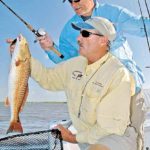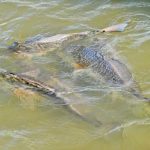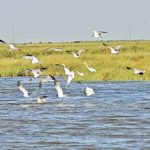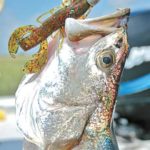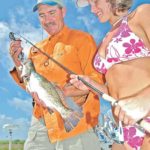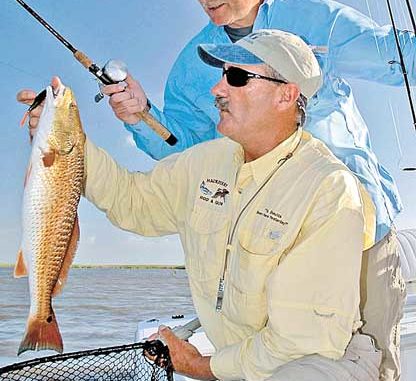
Conditions don’t have to be perfect to catch fish at Calcasieu.
With the wind blowing at 20 knots, Lake Calcasieu looked like a chocolate milkshake. Most fair-weather fishermen had cancelled their trips, but Kirk and Guy Stansel, who fish there 250 days a year, would brave rain, sleet, snow or bright, hot sun to get you in a boat and try to find you fish.
The day before I arrived, Michael and Dan Sheldon of Sheldon’s, Inc. (the maker of Mister Twister and Mepps lures), had traveled from Antigo, Wis., to enjoy fishing Lake Calcasieu. Both had limited out with their guide, Bitty Drost, on speckled trout.
“We saw the birds working, got up close to them and began to catch speckled trout on every cast,” Michael Sheldon explained. “We had our limits by 8:30.”
The Sheldons had caught more trout than anyone in camp that day. Generally, at Calcasieu, if you can find birds working, you can pinpoint the fish.
The Sheldons had come to test two new Mister Twister baits, the Mister Mino and the Mister Shad, hand-painted, hollow-tube baits. They knew because of the number of fish in Calcasieu that their new lures would get a fair test.
“The weather doesn’t get too bad for us to fish here at Hackberry,” Kirk Stansel said. “We have enough marsh and out-of-the-way places where we can generally locate protected water.
“Finding and fishing that protected water is what’s required to take redfish and trout on bad-weather days. I’ll usually run to a lee shore, go back into the marsh and look for redfish when the weather is really bad.”
Finding marsh reds
“In May and June, the shrimp, the mullet and baitfish will move back into the marsh and will be holding in 12 to 18 inches of water,” Kirk Stansel said. “The redfish will follow the baitfish out of the main lake. Everyone knows that out on the main lake you can find a school of birds working and catch speckled trout and redfish under them.
“But what most people don’t realize is that the birds will work deep in the marsh, much like they do out on the main lake, if the lake has heavy wind and bad weather.”
Schools of speckled trout and redfish will herd and corral schools of shrimp, small mullet and other baitfish, and push it to the surface of the marsh as they feed on it. As the schools of mullet, minnows and shrimp come to the surface, the seagulls overhead spot the bait and dive on it.
“Now, the bait has a real problem,” Kirk Stansel said. “It has speckled trout and redfish below it trying to eat it, and seagulls diving from above like World War II kamikaze pilots to feed on the bait as it tries to get away from the redfish and the speckled trout.
“If you see the seagulls diving on the bait, you know where the schools of speckled trout and redfish are holding.”
You may see birds working water that’s as shallow as 12 or 18 inches back in the marsh on bad-weather days. To catch the redfish in the marsh, try to determine the direction of the redfish schools, and position your boat so that the school of redfish will come to you to get within casting range. But you have to stay far enough away from the schools of redfish to keep from spooking them before you can cast to them.
“The redfish will stay in the marsh until the water temperature climbs to the high 80s or low 90s,” Kirk Stansel said. “Then they leave the marshes for summer and return again in the fall.”
Many fishermen avoid the marshes on windy days, but not the Stansel brothers.
“You can get in a marsh on a high tide, become stuck in the marsh if the tide starts falling and not be able to get out until the next high tide,” Kirk Stansel said. “However, we duck hunt in this marsh as well as fish in it, so we know where the little creeks and channels are and how to navigate them.
“Often the real secret of being able to take the redfish in the marsh is to have enough room to get your boat up on-plane and keep it on-plane until you reach the area where you want to fish.”
As long as the Stansel brothers can cross the lake without swamping their boats, they can fish.
“But, you have to find clean water in the marsh,” Kirk Stansel saaid. “We locate clean water by winding our way back into the marsh and getting into some really protected regions where the wind hasn’t turned over the water.”
Productive lures for redfish include the Mister Twister RT Slug rigged weedless when fishing in the grass or fished on a jighead.
“The jighead gives the RT Slug extra weight, making the lure easier to cast on a windy day,” Kirk Stansel said.
He rigs the RT Slug on either a No. 4/0 or 5/0 Gamakatsu hook rigged weedless, just like you’d rig it to bass fish. Redfish also like the Mepps Little Wolf Spoon, especially on windy days.
Though Kirk Stansel prefers darker colors, any color will work with schooling and heavily feeding redfish.
“Funky chicken and fire tiger are two of my favorite colors,” he said.
The fish in the marsh that the Stansels catch usually measure 23 to 25 inches long.
Catching hemmed-up reds
On the second day of our trip in bad weather, I fished with Kirk’s brother, Guy, and we had one of the most unusual redfish trips ever.
Since Hurricane Rita, erosion has occurred on the ship channel that runs through Lake Calcasieu. To stop the erosion and keep the channel open, the U.S. Army Corps of Engineers built a large riprap wall and brought all the riprap to about a two-mile area to protect the bank. As the channel got dredged each year, the workers put the sediment dredged up from the bottom in the spoilage area behind the riprap.
Guy Stansel had noticed that apparently with the building of the riprap wall, some fish became trapped on the back side of the riprap, between that rock wall and the old bank.
“We recently had seen birds working this area that’s about four miles wide by two miles long and from ankle-deep up to about waist-deep,” he said. “It was completely enclosed by riprap on the front and by land on the back.”
When we got behind the riprap, we saw three different schools of redfish working under birds. We went to the first school. Stansel threw a topwater bait, and I threw a Mepps Little Wolf Spoon. We caught our limits in about 45 minutes.
We could see the redfish pushing wakes as they chased schools of baitfish. We caught some reds in only 18 inches of water, but that little cut-off pond held numbers of fish.
Guy Stansel plans to fish this section of the lake as much as he can and as hard as he can because the fish won’t survive when the corps starts dumping the sediment it dredges from the bottom of the ship channel over into that pond to reclaim the channel.
Wade-fish on windy days
You’ll find wade-fishing for redfish deadly effective on windy days once you find protected water.
“You can move in quietly, make long casts and stay well away from the redfish,” Guy Stansel said. “We have a lot of people who come to Lake Calcasieu who prefer to wade-fish. When you see the redfish pushing a wake, take a Mister Twister RT Slug or a Mepps Little Wolf, and cast it in front of the fish. You can have a great day of catching redfish and speckled trout.
“Out on the main lake and even out on the beach, we do quite a bit of wade-fishing for both speckled trout and redfish.”
Guy Stansel usually uses 12-pound-test line all the time for both reds and trout.
“I like the 12-pound-test because it’s heavy enough to allow me to hook the fish, but it’s light enough to let me cast a really long way,” he said. “So I haven’t found a reason to change from 12-pound-test line. I like to make long casts and stay as far away from the fish as I can.
“Most of the time, there’s nothing for the fish to get hung-up on, so you have plenty of room to play them. On that 12-pound-test line, you can have a good time with the fish and break off very few of them.”
Guy Stansel fishes a 6-foot, 5-inch American Rodsmith Ultra, which weighs just a few ounces.
“Over the last few years, I’ve gone to stronger and lighter rods, and I set my drag fairly loose,” he said.
I’ve learned that at Lake Calcasieu, a muddy lake, a blowing wind and falling rain doesn’t mean I can’t enjoy bent rods, screaming drags and an ice-chest full of limits of speckled trout and redfish.
